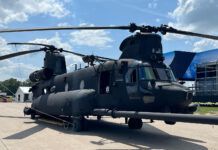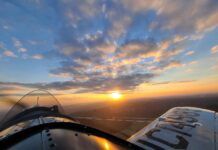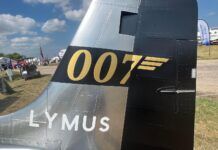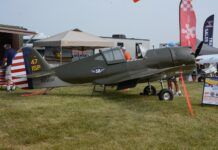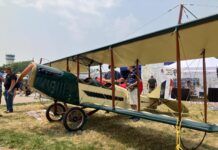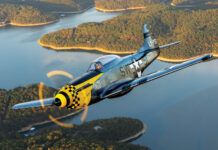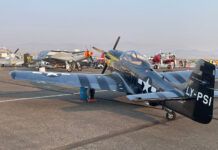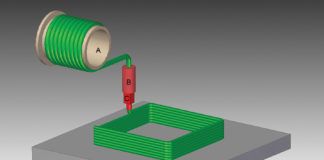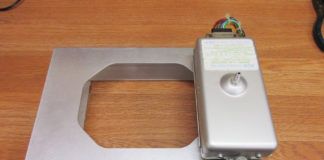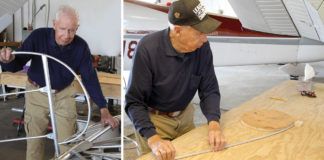Remember those golden days back in kindergarten when the crayons and coloring books came out of the cupboard? Your teacher would start that mantra, “Now children, remember to try and color inside the lines.”
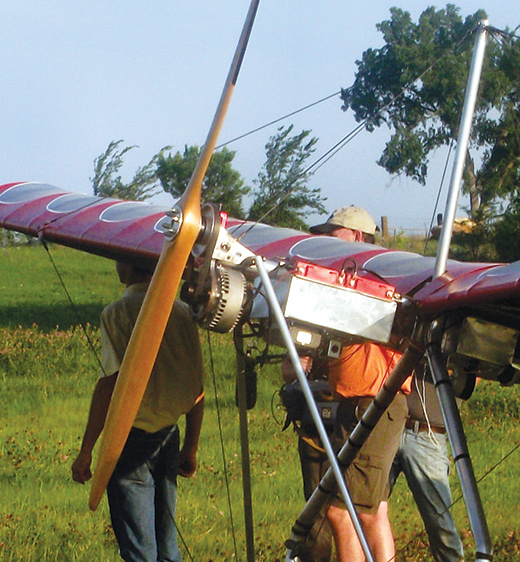
The very neat and compact engine and battery installation in the Electric Dream Classic UL.
The class would hunker down, chewing on their lips while concentrating on trying to stay inside the lines as they labored away. I, on the other hand, trying my best to stay inside the dang lines, would end up with something that looked like Picasso had painted it after a hearty meal of hallucinogenic mushrooms.
I couldn’t color then; I can’t write now. My executive signature looks like a slug on acid has slithered across the paper. I’m still trying to stay inside those blankety-blank lines.
But let’s go back to kindergarten. Think back to those “rebels” in the class: the free-thinking little boys and girls who saw the lines as a kind of baseline for creation, or just obstacles on the paper that got in the way of true creative thought.
These rebels often grew up to be engineers, programmers, architects and others who think “out of the box” when it comes to trying new things.
But going even further into the well of creation, there are those who don’t have no stinkin’ box at all to limit their free thinking. There are a few guys like that in The Dawn Patrol.
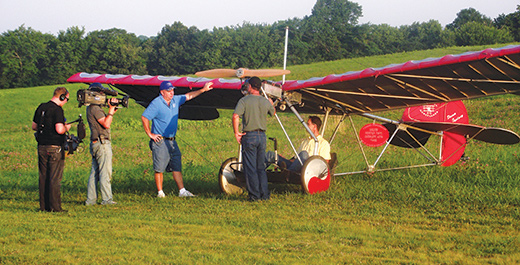
Robert Baslee (in blue) and Harvey Cleveland are interviewed by John Bowler one more time before the attempted flight.
Our Own Free Thinkers
Tom Glaeser sure didn’t have anything limiting him when he came up with the chainsaw starters for our VW-powered Graham Lee Nieuport 11 replicas. Dick Lemons is the same way. These guys never think of why something can’t be done; they just figure out the easiest way to do it. While the rest of the world believes it’s impossible and tells them so, they are staring into space, mumbling to themselves about where they’ll start. Once that little consideration is taken care of, progress gallops forward and the job gets done. They always make it look so simple, too. I’ll look at what they’ve come up with and think to myself, “Shucks, I could’a done that.” (This is only to salvage my pride. There is no way I could have done it, or even thought of it.)
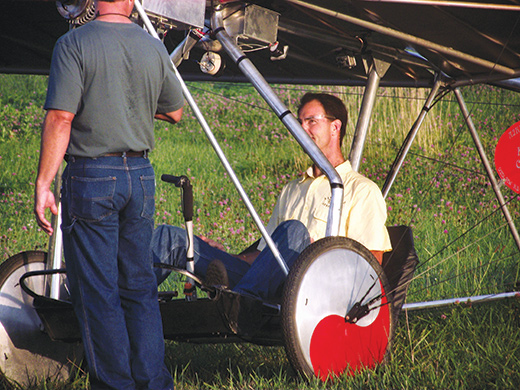
A few last words from Cleveland before twisting the motor control and headin’ down the runway.
If there’s anything that will make their nostrils flare, it’s the statement, “I really don’t think you can do it.” That’s like pouring gas on an open fire. Stand back and duck, sports fans, here they come. I’ve seen it happen over and over. Those two will go over to the corner of the hangar, away from any of us who usually tend to muddy the water, and start brainstorming about the problem. It never fails. Resolving the issue might take a while, but by golly, the Dynamic Duo will get the job done.
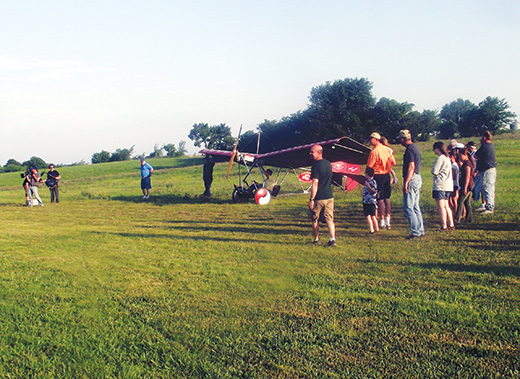
After the prop and battery change, the “downhill” attempt is ready to go. The results were disappointing.
There’s another member of The Dawn Patrol who is even worse than Lemons or Glaeser (or better, depending on your point of view). Robert “Bullwhip” Baslee, owner of Airdrome Aeroplanes, raises the free-thinking bar even higher.
Anyone who has ever spent time in Bullwhip Baslee’s “House of Pain” knows exactly what I’m talking about. He is just flat bored if he isn’t trying to solve a problem that would have other individuals beating their heads on the ground.
Well, one day last summer, Baslee was contacted by the National Geographic cable television channel about a project they were considering. His reputation as a can-do kind of guy is nationwide. The producers of the television show had read about him building four full-scale Nieuport 17s for the movie Flyboys in only 52 days.
Now just think about that for a minute: He built four full-scale WW-I flying fighter planes from scratch, framed up, covered, painted and flying in 52 days! He had a small hired crew to help, but it was still an unbelievable accomplishment. My wife, Sharon, and I are scarred veterans after building two aircraft at Baslee’s House of Pain.
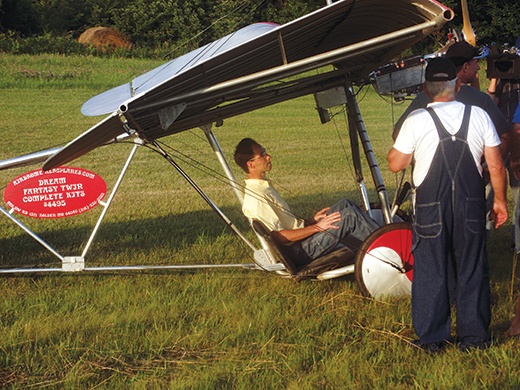
Cleveland talks to Jim Hickman about what the instruments showed during the attempt.
In fact, everyone in The Dawn Patrol has spent time there now and then, helping with different projects. We usually go over to Baslee’s just to see what’s going on, but when you walk in the door, you’re handed a drill or riveter or given some kind of job to do. No idle hands are allowed. We refer to working at warp speed as “Baslee mode.” Basically the Baslee mode mantra is, “Lead, follow or get the heck outta the way, but do something, and do it now!”
There are no “blue sky moments” in the House of Pain either. Some builders might have a table and a set of tail feathers framed up in 52 days. I’ve seen it. I’ve done it. Procrastination is a valuable but often forgotten skill.
Throwing Down the Challenge
Anyway, the TV show’s host, John Bowler, had researched Baslee’s Airdrome Aeroplanes web site and had noticed his Dream Classic ultralight. The aircraft was powered by a popular 40-horsepower two-stroke engine. The National Geographic Channel was going to make a series of programs called “Mad Scientists,” which would challenge various free-thinking individuals to come up with something completely different.
What they challenged Baslee with was definitely new to him. They wanted him to build something that he had never built before and make it fly.
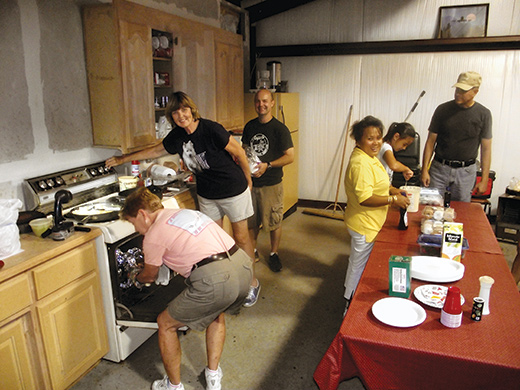
Come and get it! Sharon Starks, Ronnie Rollins, Dave Laur, Susan Baslee, Haylee Cleveland and Jeff Givens in the midst of slingin’ hash and scramblin’ eggs. (This was the only reason some of the crowd showed up.)
That in itself was a little challenging because he has built 63 aircraft, most from scratch. These include powered parachutes, Long-EZs and an early Glasair, not to mention a passel of WW-I aircraft and even some earlier aircraft like the Bleriot XI and a 1910 Demoiselle replica. Baslee had no idea what in the world Bowler would dream up for him to do, but he has never walked away from a new challenge.
In the walk around Baslee’s plant, Bowler saw a small electric wind generator sitting under the workbench. Then someone on the film crew made a joke: “What about an electric airplane?”
Baslee came back with a comment along the lines of, “We’re going to need a really long extension cord, and then we’ll just fly it around in a tight circle like a U-Control model.” That was the moment the germ of an idea was born. Bowler wanted to challenge Baslee to convert the Dream Classic from gas engine to electric motor in just 48 hours—and make it fly.
The first meeting clarified the rules of the challenge. Baslee would be allowed to have all the necessary tools, car batteries, wind-generator “motor,” propeller, controllers, wiring, aluminum and assorted miscellaneous accoutrements on hand, ready to go. The most intimidating rule stipulation was that all of the components had to be “off the shelf.” No exotic batteries, motors or super-expensive parts were allowed. The 48-hour challenge would start on Friday morning, with the test flying scheduled for Sunday morning.
Scrounging around the shop got a lot of the stuff they needed for the project. Anything else was found at the local hardware and auto-parts stores. The TV crew spent a few days interviewing Baslee, touring the Airdrome Aeroplanes plant and watching demonstrations of some of his ultralight and WW-I designs. Baslee even took Bowler up for a flight in a two-seat ultralight trainer for some actual hands-on-the-stick flight time.
By Thursday afternoon, all of the parts were assembled, but it didn’t take long for the first disastrophe to strike. As a smoke test, everything was hooked up on a test bench and switched on. The first motor was faulty and burned out in a few seconds. It just so happened that Harvey Cleveland, the designated pilot for the event, had dropped in to Baslee’s in his ’48 Aeronca Champ to check on progress. He and Baslee did some calling around, and they found another motor in Columbia, Missouri. Without batting an eye, Cleveland jumped in the Champ and roared off. It was about a 45-minute flight. The motor was waiting for him at the Columbia airport. He was back to Baslee’s in plenty of time to bench-test it, and this one was healthy. All was ready for the 48-hour challenge.
Let the Games Begin
Friday morning early, the crew was ready to go into Baslee mode. The first task was removing the gas engine, fuel tank and all of the assorted plumbing and controls. That took Baslee’s merry crew about 90 minutes.
While all that was going on, Baslee and his right-hand man, Jim Hickman, fabricated and installed the engine mount for the new electric motor, battery box, cables and switches. All of these parts were drawn out, cut out, riveted or bolted together and mounted on the fuselage keel.
While Hickman was straw-bossing all this activity, Baslee’s friend Bill Martin was figuring out the wiring, motor controls and general placement of all the electrical gear. In Baslee mode, this only took a few hours.
The TV crew was filming all this feverish activity, trying not to get trampled underfoot. You could tell they were new to the type of activity that’s normal at the House of Pain.
By early afternoon, the airplane was ready. A short full-power pull-test measured 140 pounds of pull. That was a very promising sign for the big day on Sunday. The plane was broken down, put on a trailer and trucked the short 20-minute drive to Baslee’s test field, west of Warrensburg, Missouri. There, the plane was assembled, and all was ready for the challenge. The weather forecast for Sunday was brutal. Dangerous heat advisories had already been posted, with strong gusty winds from the south. The revised plan was for everyone to gather at the airport at 0530 hours to “get ’er done” quick.
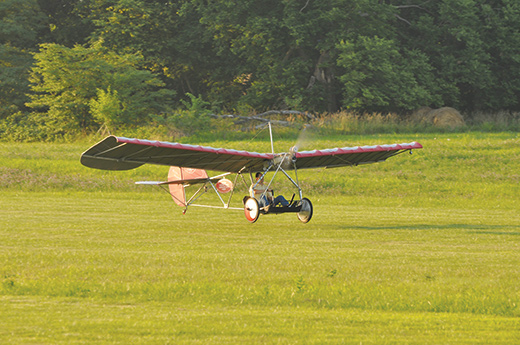
Late in the afternoon on Sunday, we have flight! Not a whole lot of it, but the challenge had been met. Woo hoo!
Walking the Walk
At 0530 hours Sunday morning, there were pleasant temperatures at the field and light winds. For a July morning in mid-Missouri, it was swell. But we knew it would be a totally different story in just a few hours.
The TV crew was all set up, and the plane was positioned at the end of the runway. After a few moments of cameramen scurrying up and down the runway, they were ready to roll. The crowd was given final instructions to keep them from getting killed. Then everything was set for the trial. Cleveland was in the cockpit, ready to hit the switch. Having already done all they could do, Baslee and his crew were vibrating in place alongside the runway.
The 5- to 10-mph wind was a direct 90° crosswind from the right. For a “normal” aircraft, this would be a non-issue. For a super-light ultralight, it was a crosswind!
Cleveland said, “Fire in the hole,” hit the switch, and, with a muted hum from the motor accompanied by cheers from the crowd, down the runway he went. You could see the ailerons were at hard right to try and keep the upwind wing down and the rudder was hard left. I knew that all this extra drag was not a good thing for an aircraft trying to fly with minimum power.
Cleveland got the tail up and went down the runway, gathering speed. It looked like it might have gotten light on the gear.
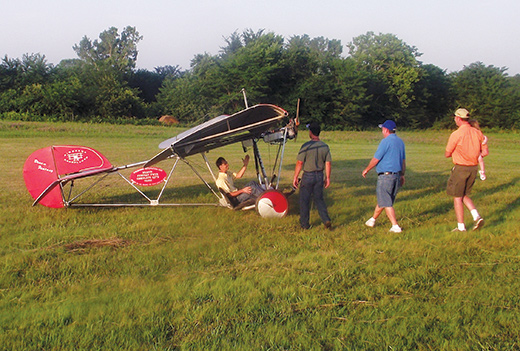
Cleveland shuts it down after the short but memorable flight that proved it can be done.
But that was it. The off-the-shelf batteries had already given their all. The engine started to seriously sag. He was able to turn the plane around and nurse it back to the starting point. As he went by the crowd, we could all smell the odor of cooked electronics.
The engineering crew gathered in a huddle around the plane, pointing and gesturing as thoughts and opinions flowed forth in a rushing torrent.
The Dream Classic was pushed back to the hangar. A set of fresher batteries was installed. A prop with different pitch was bolted on.
It was crunch time. The 48-hour challenge time limit was running out. The plane was pushed back to the end of the much shorter north/south runway and put into position to try and get the maximum possible positive conditions for this test: directly into the wind with a downhill takeoff run. This was going to be it, too. The gusty winds were building and the promised high temperatures and humidity were ominously waiting in the wings.
With everything as good as it was going to get, Baslee told Cleveland to go directly to full throttle and go for broke. Cleveland hit the switch and turned the motor controller to “Ya hah.”
The results this time were worse. After an agonizing run of only 10 seconds or so, the tired batteries were drained. The plane never even got light on the gear.
We were done. The 48-hour time limit had passed. Besides that, the weather had deteriorated to the point that flying any ultralight was an invitation to a disastrophe.
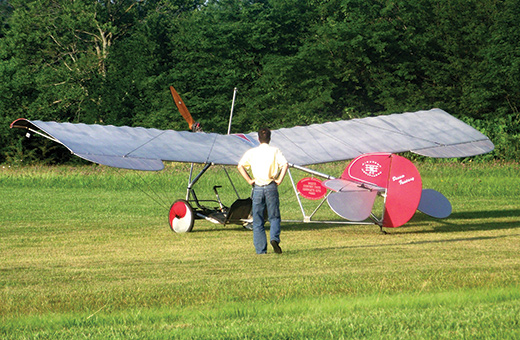
It’s done! Cleveland looks at the DRT (Dear Right There) Dream Classic after the last attempt.
It’s Miller Time (or at Least Breakfast Time)
Everyone moved to the air-conditioned office, where Sharon Starks, Ronnie Rollins, Susan Baslee, Dave Laur, Kim Cleveland and Jeff Givens were cooking up a real country breakfast for the ravenous herd. Bacon, eggs, sausage, pancakes, toast, rolls, doughnuts, fruit, cookies, juice and coffee were ready to be served. The atmosphere was cheerful and positive. Was the effort a failure? It all depends on your point of view. For a crash project with all the limitations that Baslee had to labor under, it just showed what wouldn’t work.
Epilogue
As we were pushing the plane back to the shelter of a hangar to be tied down, Baslee made a statement that foretold things to come. He said, “I am not done with this!”
While everyone else was stuffing their faces in the airport office, Baslee and his engineering crew were still in the hangar mumbling about too much internal resistance in the batteries and options to get it to work. This was an example of guys who are creative thinkers. This wasn’t a failure. They just found out some things that didn’t work. Now it was time to start exploring new options and finding something that would work.
And they did. Late that afternoon, after the crowd had left, the weather improved. The winds dropped, and just as the shadows were lengthening, they tried again. With a different prop, fully charged batteries and better flying conditions, the plane flew. Cleveland nursed it off the ground for 10 seconds with an altitude of about 5 feet, and they did get it on video for the TV show. And so, in Missouri, the adventure continues.
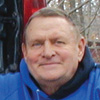
![]()
Dick Starks has written two books about the joy of flying; “You Want To Build And Fly A What?” and “Fokkers At Six O’clock!!” He was the recipient of Flying’s 2001 Bax Seat Award “for perpetuating the Gordon Baxter tradition of communicating the excitement and romance of flight.” Dick and his wife, Sharon, both fly WW-I replica aircraft.


